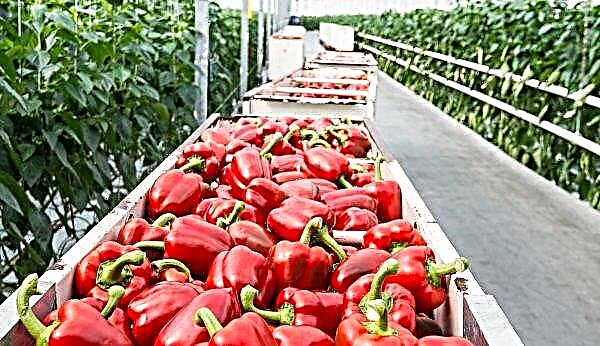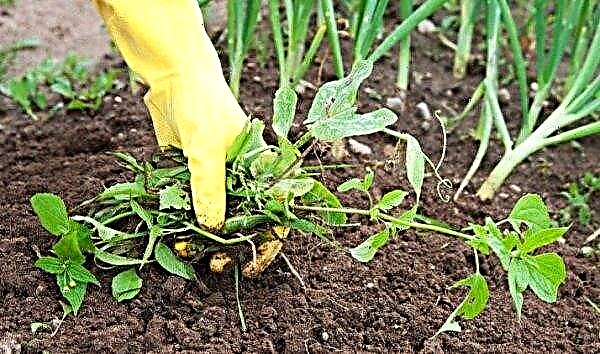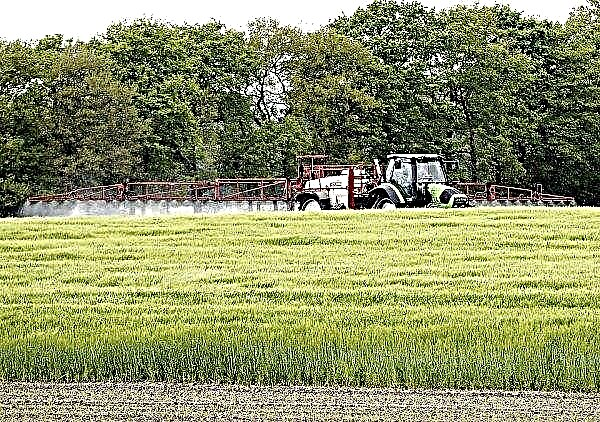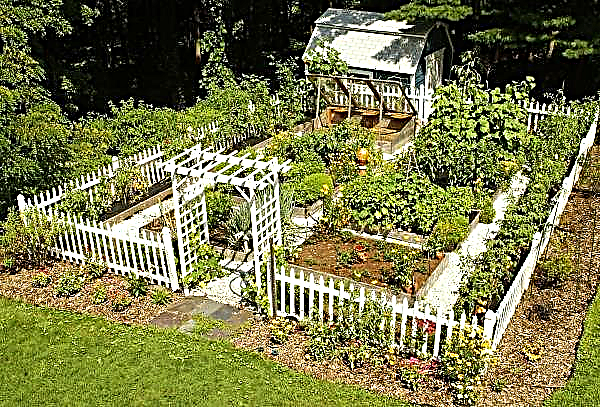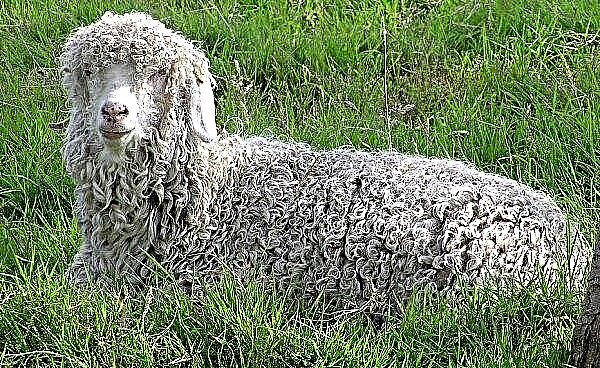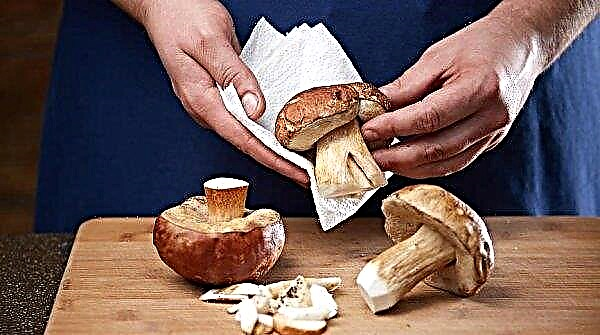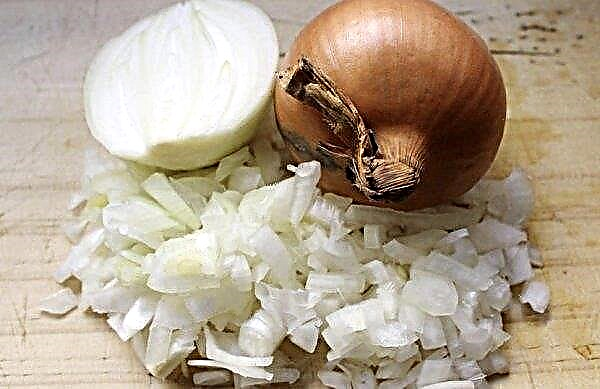Carrots are actively grown in many large and small households. One of the key points affecting the yield of a given crop and the attractive presentation of the fruit is proper watering. This article lists the reasons why carrots need moisture, signs of a lack of water for the plant, the rules of irrigation, as well as the features of irrigation of beds in a greenhouse and in open ground.
Why water the carrots
When growing carrots, watering the beds is carried out depending on weather conditions and the age of the plants. At different stages of growth, the culture needs different volumes of liquid, but you need to irrigate the beds with this crop constantly.
Did you know? In addition to root vegetables, you can eat green tops of carrots as food — salads, soups, as well as aromatic herbal tea are prepared from it.
Here are the main reasons for the need for proper watering of plants:
- if there is a shortage of water in the soil during planting, the sown seeds will not germinate;
- if young shoots do not receive enough moisture, they will dry out and die;
- with a lack of moisture in the soil in the second half of summer (during the formation of the fruit), the root crops will be small, and their flesh will become hard and bitter in taste;
- if you irrigate the beds irregularly, the fruits will have an uneven shape and dry pulp;
- in waterlogged soil, the plant forms additional roots - they make the surface of the fruit uneven and spoil its appearance.

How to understand that carrots need watering
Carrots belong to moisture-loving crops, so a lack of moisture immediately affects the appearance of plants. In such cases, it is urgent to water the beds, but irrigation should be carried out in several stages. This is necessary so that dehydrated plants do not experience shock from abrupt and abundant soil moisture.
Signs of water scarcity for this crop are listed below:
- the soil around the plants becomes dense and hard, crusty;
- plant leaves become dark green and dull;
- the tops look withered and dry, the edges of the leaves curl inward;
- the upper part of the fruit protruding from the soil looks wrinkled and lethargic;
- the root crop extracted from the soil has an uneven shape and hard flesh.
How and how to properly water the carrots
Depending on the climatic conditions of a particular region and the timing of planting, carrots are grown in open ground or in a greenhouse. Regardless of the chosen method of cultivation, for normal growth, plants need regular watering. But the rules for irrigation of beds in a greenhouse and open ground are somewhat different from each other, so in the next article they will be listed separately for each method of cultivation.
In the open ground
Most often, carrots are grown in open ground, whose moisture plays a key role in obtaining a generous harvest of delicious fruits. A lack of moisture has a detrimental effect on plants, but an excess of water in the soil is no less dangerous.
Important! Since the second half of August, watering carrots should be especially uniform — with irregular irrigation of the earth, the formed fruits begin to crack.
The basic rules for watering this crop in open ground are listed below:
- during spring planting, the soil is usually sufficiently moistened with melt water, so watering the beds before planting is not necessary;
- if the winter was not snowy or the seeds are planted in the summer, then the soil must be additionally moistened before sowing;
- during irrigation, the soil should get wet to a depth of about 20 cm;
- during the period of active growth of green mass, watering is carried out every 3-5 days, spending about 5 liters of water per 1 m²;
- the first feeding with liquid fertilizers is carried out 30 days after seed germination, using an aqueous solution of ammonium nitrate (20 g of fertilizer per 10 l of water) and potassium (20 g of powder per 10 l of liquid);
- to prevent the appearance of carrot flies and other pests, you can water the plants with saline (5 l per 1 m²). Fertilizers are applied 3 times per season with an interval of 14 days, starting from the first decade of June. About 300 g of salt is consumed for the first feeding, 450 g for the second, and 600 g (for 10 l of water) for the third;
- all liquid fertilizer solutions must be introduced into the groove dug between the rows of carrots at a distance of 5–9 cm from the plants. Moreover, for feeding plants on an area of 1 m² 10 l of the mixture are consumed;
- the second top dressing is carried out approximately 3 weeks after the first fertilizer application. To do this, prepare a solution of superphosphate (30 g per 10 l of water) and potassium (30 g per 10 l of liquid);
- at the stage of formation of root crops, watering is carried out once every 6–10 days, but at least 20 liters of water are already consumed per 1 m²;
- the last time the beds are fed in August, using an aqueous solution of potassium chloride (30 g of substance per 10 l of water) to improve the taste of the fruit;
- 2-3 weeks before harvesting, watering the beds should be stopped so that the fruits do not crack and are better stored.
Video: Proper Moqui Watering
In the greenhouse
To get a rich harvest of early carrots, seeds are often planted in a greenhouse. In order for the planting material to germinate as soon as possible, and the fruits are smooth and tasty, it is necessary to provide the plants with sufficient moisture.
Did you know? The roots of wild carrots are purple or light yellow in color. Varieties with orange-colored fruits were bred in the Netherlands.
The basic rules for watering a crop when grown in a greenhouse are listed below:
- if at the time of planting the seeds the soil is very dry, then before sowing the seeds it is watered with a small amount of warm water;
- after the appearance of the first seedlings, the active growth of carrots begins, therefore at this stage it is impossible to prevent the drying of land on the beds;
- during the active growth of tops, carrots in the greenhouse are watered 2 times a week, but in rainy and cool weather it is permissible to irrigate the beds once every 7 days;
- about a month after seed germination, the carrots are watered with a liquid nitrofoska solution (1 tbsp. l substance per 10 l of water), spending 5 l of fertilizer per 1 m²;
- during the growth period of young seedlings per 1 m², at least 3 liters of water must be consumed;
- 3 weeks after the first dressing, the beds are again watered with an aqueous solution of nitrophoska at the rate of 7-8 liters of fertilizer per 1 m²;
- after the plants began to form root crops, the beds are irrigated once every 7 days;
- so that the fruits are large and even during their formation on 1 m² of area you need to spend about 10-15 liters of water;
- to improve the taste of carrots, it is possible to water the plants with saline during the ripening period of root crops (for the treatment of 1 m² 1 part of salt is used per 10 liters of warm boiled water);
- 10-14 days before the planned harvest, you need to stop watering the carrots so that the fruits do not absorb excessive moisture.
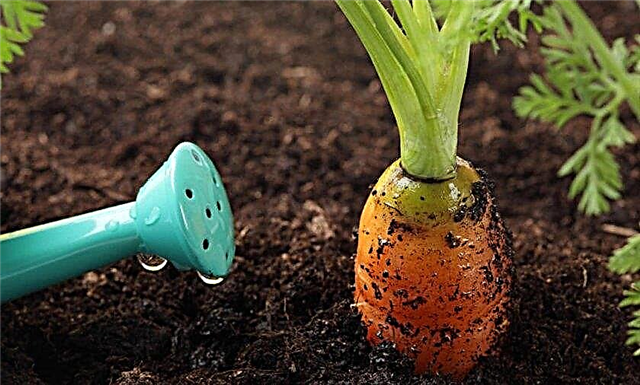
Features of watering carrots immediately after planting
After the carrot seeds have been planted in moist soil, it is recommended to cover them with a film to create optimal greenhouse conditions. At this time, you do not need to water the beds, because even careful irrigation with water from a watering can can wash small seeds out of the ground.
If the soil was sufficiently moist before planting, a special environment forms between the surface of the earth and the film, and condensation accumulates on the lower surface of the shelter. It is quite enough to moisten the soil and germinate the seeds, but as soon as the shoots appear, the film must be removed.
Important! If at the time of planting the soil, which was sprinkled with seeds from above, is too dry, then you can sprinkle it a little with a small amount of water from the spray gun.
Useful tips for watering carrots
In order for the plants to grow well and form large, even fruits, you need to be careful about watering the beds.
In addition to all the rules listed above, there are several more general recommendations for plant irrigation:
- so that water is quickly absorbed into the soil and quickly reaches the roots of the plant, after irrigation, you need to slightly loosen the beds;
- after the thinning planting procedure, plants need to be watered to help restore roots as soon as possible;
- the moistening of the beds should be uniform so that each section of the soil receives the same amount of water;
- drying of the soil or its saturation with moisture should not be allowed - in the first case, the plants will dry up and die, and in the second they will begin to rot;
- for irrigation, you can use standing water, the temperature of which coincides with the temperature of the air in the street;
- you can not water the plants with spring cold water - this can cause root crops to rot;
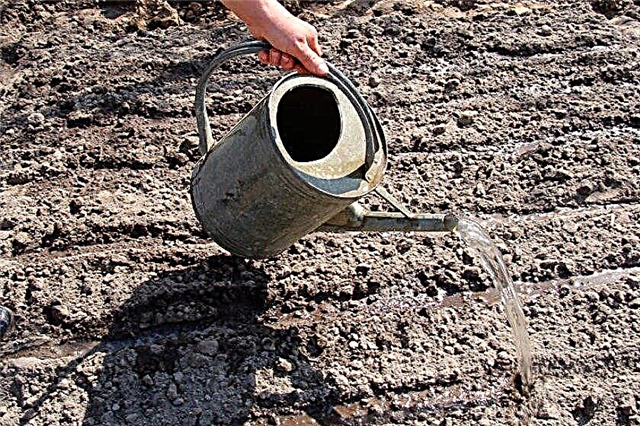
- for uniform moistening, the irrigation of the beds is carried out using a watering can. It is impossible to water carrots from a hose without a special nozzle, because a strong pressure of water can displace the roots of plants in the soil;
- to prevent waterlogging of the soil, it is recommended to apply the right amount of water in small portions and take breaks, allowing the water to soak into the soil;
- so that moisture evaporates less and is completely absorbed into the soil, you need to water the carrots in the early morning or evening;
- when saline or liquid fertilizers are applied to the soil, the carrots should be well poured with clean water before and after this procedure;
- in September, the beds are not watered - during this period, plant growth stops and they no longer need water.
Important! So that the soil on the beds remains wet longer, you can mulch it with a layer of dry straw or humus.
Watering has a very important place in growing carrots, so it should be plentiful and timely. Using the recommendations listed in this article, you can always correctly determine how and what you need to water the plants.



